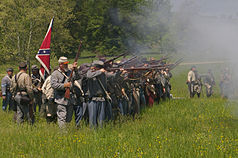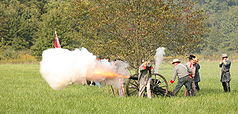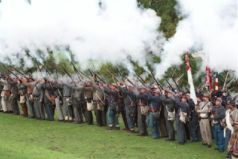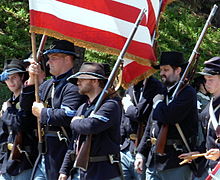- American Civil War reenactment
-
 Confederate reenactors fire their rifles during a reenactment of the Battle of Chancellorsville in May 2008.
Confederate reenactors fire their rifles during a reenactment of the Battle of Chancellorsville in May 2008.
 Confederate artillery reenactors fire on Union troops during a Battle of Chickamauga reenactment in Danville, Illinois.
Confederate artillery reenactors fire on Union troops during a Battle of Chickamauga reenactment in Danville, Illinois.
American Civil War reenactment is an effort to recreate the appearance of a particular battle or other event associated with the American Civil War by hobbyists known (in the United States) as Civil War reenactors or Civil War recreationists. Although most common in the United States, there are also American Civil War reenactors in Canada, the United Kingdom,[1] Germany,[2] Australia,[3] and Italy.[4]
Contents
History
Reenacting the American Civil War began even before the real fighting had ended. Civil War veterans recreated battles as a way to remember their fallen comrades and to teach others what the war was all about.[5] The Great Reunion of 1913, celebrating the 50th anniversary of the Battle of Gettysburg, was attended by more than 50,000 Union and Confederate veterans, and included reenactments of elements of the battle, including Pickett's Charge.[6] Modern reenacting is thought to have begun during the 1961–1965 Civil War Centennial commemorations.[7] Reenacting grew in popularity during the 1980s and 1990s, due in large part to the success of the 125th Anniversary reenactment near the original Manassas battlefield, which was attended by more than 6,000 reenactors.[8] That year, Time magazine estimated that there were more than 50,000 reenactors in the U.S.[9]
In 1998, the 135th anniversary re-enactment of the Battle of Gettysburg took place near the original battlefield. There have been several estimates on the number of participants, but it is widely agreed that it was the largest re-enactment ever held anywhere in the world, with between 30,000 and 41,000 re-enactors participating. This event was watched by about 50,000 spectators.[10]
Participation
See also: List of historical reenactment groupsAmerican Civil War reenactments have drawn a fairly sizable following of enthusiastic participants, young and old, willing to brave the elements and expend money and resources in their efforts to duplicate the events down to the smallest recorded detail. Participants may even attend classes put on by event sponsors where they learn how to dress, cook, eat, and even "die" just as real Civil War soldiers would have. Most reenactments have anywhere from 100 to 1,000 participants, portraying either Union or Confederate infantry, artillery, or cavalry forces. Some people, though uncommon, may portray Engineers or Marines. The 135th anniversary Gettysburg reenactment (1998) is generally believed to be the most-attended reenactment, with attendance estimates ranging from 15,000[11] to over 20,000 reenactors.[12]
Reasons given for participating in such activities vary. Some participants are interested in getting a historical perspective on the turbulent times that gripped the nation, particularly if they can trace their ancestry back to those who fought in the war. In some cases, if there are not enough reenactors present on one side, reenactors from the other side are asked to change sides, or "galvanize", for the day/event.[13]
Although many periods are reenacted around the world, Civil War reenactment is, by far, the most popular activity in the US.[14] In 2000, the number of Civil War reenactors was estimated at 50,000,[15] though the number of participants declined sharply through the ensuing decade, to around 30,000 in 2011.[16] Possible reasons for the decline include the cost of participating and the variety of other entertainment options.[16]
Although women and children commonly participate in reenactments as civilians (portraying, for example, members of a soldiers' aid society), some women also take part in military portrayals. This is controversial within the reenactment community; while there were a small handful of women who may have fought in the conflict, almost all of them did so disguised as men. Attitudes on this topic seem to vary widely.[17]
Categories of reenactors
Reenactors are commonly divided (or self-divide) into three categories, based on the level of concern for authenticity.[14][18]
Farbs
Some, called "Farbs" or "polyester soldiers"[19] are reenactors who spend relatively little of their time or money maintaining authenticity with regard to uniforms, accessories, or even period behavior. The 'Good Enough' attitude is pervasive among farbs, although even casual observers may be able to point out flaws. Blue jeans, tennis shoes, polyester (and other man-made fabrics), zippers, velcro, snoods, and modern cigarettes are common issues.
The origin of the word "farb" (and the derivative adjective "farby") is unknown, though it appears to date to early centennial reenactments in 1960 or 1961.[20] An alternative definition is "Far Be it for me to question/criticise",[21][22] or "Fast And Researchless Buying".[23] Some early reenactors assert the word derives from German Farbe, color, because inauthentic reenactors were over-colorful compared with the dull blues, greys or browns of the real Civil War uniforms that were the principal concern of American reenactors at the time the word was coined,.[24][25] According to Mr. Burton K. Kummerow, a member of "The Black Hats, CSA" reenactment group in the early 1960s, he first heard it used as a form of fake German to describe a fellow reenactor. The term was picked up by George Gorman of the 2nd North Carolina at the Centennial Manassas Reenactment in 1961, and has been used by reenactors ever since.[26]
Mainstream
Another group of reenactors often is called "Mainstream." These reenactors are somewhere between farb and authentic. They are more common than either farbs or authentics.[citation needed]
Most mainstream reenactors make an effort at appearing authentic, but may come out of character in the absence of an audience. Visible stitches are likely to be sewn in a period-correct manner, but hidden stitches and undergarments may not be period-appropriate. Food consumed before an audience is likely to be generally appropriate to the early 1860s, but it may not be seasonally and locally appropriate. Modern items are sometimes used "after hours" or in a hidden fashion. The common attitude is to put on a good show, but that accuracy need only go as far as others can see.[citation needed]
Progressive
At the other extreme from farbs are "hard-core authentics" or "progressives", as they prefer to be called.[27] Sometimes derisively called "stitch counters"[28] many people have misconceptions about hardcore reenactors.[29]
Hard-cores generally seek an "immersive" reenacting experience, trying to live, as much as possible, as someone of the 1860s might have. This includes eating seasonally and regionally appropriate food, sewing inside seams and undergarments in a period-appropriate manner, and staying in character throughout an event.[30] The desire for an immersive experience often leads hard-core reenactors to smaller events, and to setting up separate camps at larger events, which often other reenactors often perceive as elitism.[31]
Character Reenactors
Some reenactors portray a specific officer or person such as General Robert E. Lee, U. S. Grant, President Jefferson Davis or Abraham Lincoln, or a less well known officer such as Col. Abram Fulkerson. Character reenactors may also portray a civilian man, woman, or child of significance. These reenactors often do not participate in the actual combat portion of the reenactment and serve as narrators to the audience during the battle. Often, character reenactors have extensively researched the person they portray and present a first-person narrative of his story.
Civilian reenactors
In addition to military reenactment, a significant part of Civil War reenactment includes the portrayal of civilians, including men, women, and children from infants to young adults. This can include portrayals as diverse as soldiers' aid societies, sutlers, saloon proprietors, musicians, and insurance salesmen.
Types of Civil War reenactments
See also: List of historical reenactment eventsPublic events
A typical Civil War Reenactment takes place over a weekend with the reenactors arriving on Friday and camping on site while spectators view the event on Saturday and Sunday. Usually each reenactment is centered around a Saturday battle and Sunday battle (often, but not always, intended to recreate an actual battle from the Civil War) in addition to many of the activities listed below. Essentially, a traditional public reenactment is a three day long affair that incorporates elements from each of the following categories.
Living histories
Living histories are meant entirely for education of the public. Such events do not necessarily have a mock battle but instead are aimed at portraying the life, and more importantly the lifestyle, of the average Civil War soldier. This does include civilian reenacting, a growing trend. Occasionally, a spy trial is recreated,and a medic too. More common are weapons and cooking demonstrations, song and leisure activities, and lectures. These should not, however, be confused with Living history museums. These outlets for living history utilize museum professionals and trained interpreters in order to convey the most accurate information available to historians.
Living history is the only reenactment permitted on National Park Service land; NPS policy "does not allow for battle reenactments (simulated combat with opposing lines and casualties) on NPS property." [32]
Public demonstrations
Public demonstration in a parade for the sesquicentennial of Red Wing, Minnesota.
Public demonstrations are smaller mock battles put on by reenacting organizations and/or private parties primarily to show the public how people in the 1860s lived, and to show the public civil war battles. The battles are only loosely based on actual battles, if at all, and may consist of demonstrations of basic tactics and maneuvering techniques.
Scripted battles
Scripted battles are reenactment in the strictest sense; the battles are planned out beforehand so that the companies and regiments make the same actions that were taken in the original battles. They are often fought at or near the original battle ground or at a place very similar to the original. A common question of non-reenactors concerns the determination of who "dies" over the course of the battle. Reenactors commonly refer to the act of being killed or wounded as "taking a hit" and is typically left up to the individual's discretion, although greatly influenced by the events of the battle. Because most battles are based on their historical counterparts it is generally understood when to begin taking hits and to what extent.[33]
Closed events
Total immersion events
Total immersion events are made up solely of progressive ("hard-core authentic") reenactors, who often refer to them as "Events By Us and For Us" or "EBUFU". As the names imply, these events are held for the personal edification of the reenactors involved, allowing them to spend an extended time marching, eating, and generally living like actual soldiers of the Civil War.[30] Total immersion events generally require participants to meet a high standard of authenticity, and in most cases little or none of the event will be open to public viewing.
Tactical battles
Main article: Tactical eventTactical battles, which are not usually open to the public,[34] are fought like real battles with each side devising strategies and tactics to defeat their opponent(s). They have no script, a basic set of agreed-upon rules (physical boundaries, time limit, victory conditions, etc.), and onsite judges or referees,[35] and so could be considered a form of live action role-playing game. Tactical battles might also be considered a form of experimental archaeology.[36]
Reenactment and media
Motion picture and television producers often turn to reenactment groups for support; films like Gettysburg, Glory and Gods and Generals benefited greatly from the input of reenactors, who arrived on set fully equipped and steeped in knowledge of military procedures, camp life, and tactics.[37]
In a documentary about the making of the film Gettysburg, actor Sam Elliott, who portrayed Union General John Buford in the film, said of reenactors:
“ I think we're really fortunate to have those people involved. In fact, they couldn't be making this picture without them; there's no question about that. These guys come with their wardrobe, they come with their weaponry. They come with all the accoutrements, but they also come with the stuff in their head and the stuff in their heart. ” At times, however, the relationship between reenactors and filmmakers has been contentious. Although reenactors for Gettysburg were unpaid, money was contributed on their behalf to a trust for historic preservation; however, some subsequent productions have offered no such compensation. Also, in some cases reenactors have clashed with directors over one-sided portrayals and historical inaccuracies.[39] Some producers have been less interested in accuracy than in the sheer number of reenactors, which can result in safety issues. Finally, large film productions, like Gettysburg, can draw enough reenactors to cause the cancellation of other events.[40]
See also
Notes
- ^ [1] More than 50,000 British citizens served during the American Civil War.[2]
- ^ [3]
- ^ [4]
- ^ [5]
- ^ Hadden. p 4 "Civil War reenacting was done almost from the beginning of war, as soldiers demonstrated to family and friends their actions during the war, in camp, in drill, and in battle. Veterans organizations recreated camp life to show their children and others how they lived and to reproduce the camaraderie of shared experience with their fellow veterans."
- ^ Heiser.
- ^ Hadden. p 4 "Without a doubt, Civil War reenactment got its boost during the centennial, which also saw the birth of the North-South Skirmish Association (NSSA)."
- ^ Hadden. p 6 "In 1986, the first of the 125th Anniversary battles was held near the original battlefield of Manassas. More than anything, this mega-event sparked an interest in the Civil War and reenacting."
- ^ Skow.
- ^ reenactor.net, 2010" Source 6", 2/21/2010
- ^ Hadden. p 15
- ^ Stanton. p 64
- ^ Hadden p 220
- ^ a b Strauss. "In the United States, hobby organizations participate in the public reenactment of historical events. The most popular is Civil War reenacting, which can be viewed as a manifestation of the unresolved nature of that war...Among reenactors, the quest for historical authenticity is considered a core value."
- ^ "Massachusetts company still rolls out hardtack dough for Civil War enthusiasts". CNN. 2000-08-07. Archived from the original on 2008-03-07. http://web.archive.org/web/20080307090245/http://archives.cnn.com/2000/FOOD/news/08/07/civilwar.biscuits.ap/. Retrieved 2008-08-14. "Word spread among roughly 50,000 Civil War buffs, and business boomed."
- ^ a b Douban, Gigi (2011-07-04), Fewer People Participate In Civil War Reenactments, National Public Radio, http://www.npr.org/2011/07/04/137609367/fewer-people-participate-in-civil-war-reenactments, retrieved 2011-07-19
- ^ "Women Military Reenactor's Homepage". Archived from the original on 2005-05-15. http://web.archive.org/web/20050515205452/http://www.geocities.com/womansoldier/. Retrieved 2009-10-29.
- ^ Stanton. p 34
- ^ Hadden p 209 and p 219
- ^ Hadden p 8 Ross M. Kimmel states that it was used at the Manassas reenactment in 1961...George Gorman and his 2nd North Carolina picked up the term at the First Manassas Reenactment in 1961 and enjoyed using it constantly with condescension and sarcasm directed toward other units.
- ^ Hadden, p 8
- ^ [6]
- ^ Hadden p 8 Juanita Leisch calls it "Fast And Researchless Buying," and other sources insist it came from the Bicentennial and Revolutionary War groups and means "Fairly Authentic Royal British."
- ^ Hadden p8
- ^ [7]
- ^ Hadden, p 219-220
- ^ Hadden p 138
- ^ Hadden p 224
- ^ Hadden, p 138 "The hard-core movement is often misunderstood and sometimes maligned."
- ^ a b Hadden p 138 "Like soldiers of the Civil War, progressives experience the same poor conditions that the original soldiers did, camping without tents and sleeping out exposed to the cold and rain. They spend weekends eating bad and insufficient food, and they practice a steady regimen of work, marching, and drill. They suffer the cold, carrying insufficient clothing and blankets as well as sleeping campaign-style by spooning with each other for warmth."
- ^ Hadden p 139
- ^ "Wilson's Creek National Battlefield FAQ". National Park Service. 2008-07-25. http://www.nps.gov/wicr/faqs.htm.
- ^ Farhi, Paul (2011-07-15), "Civil War reenactment etiquette: How — and when — to die on the battlefield", The Washington Post, http://www.washingtonpost.com/lifestyle/style/civil-war-reenactment-etiquette-how--and-when--to-die-on-the-battlefield/2011/07/11/gIQAgNcRGI_print.html, retrieved 2011-07-19
- ^ Hadden p 224 "Sometimes they are closed events, in which the public is not invited to observe."
- ^ Hadden. p 23
- ^ Hadden. p 23 "By living like the soldiers did, even for just a short time, the reenactors gain better understanding of how to wear the uniform and use the equipment."
- ^ Details may be found in the "making of" features on the DVD versions of both films.
- ^ This documentary can be found on the DVD of the film Gettysburg.
- ^ Hadden. p 7
- ^ Hadden. p 8
References
- Hadden, Robert Lee. "Reliving the Civil War: A reenactor's handbook". Mechanicsburg, PA: Stackpole Books, 1999.
- Heiser, John (1998-09). "The Great Reunion of 1913". National Park Service. http://www.nps.gov/archive/gett/getttour/sidebar/reunion13.htm. Retrieved 2008-08-15.
- John Skow, et al., "Bang, Bang! You're History, Buddy," Time (August 11, 1986): 58.
- Stanton, Cathy (1999-11-01). "Reenactors in the Parks: A Study of External Revolutionary War Reenactment Activity at National Parks" (PDF) National Park Service. Retrieved on 2008-07-28.
- Strauss, Mitchell (2001). "A Framework for Assessing Military Dress Authenticity in Civil War Reenacting". Clothing and Textiles Research Journal (International Textile & Apparel Association, Inc.) 19 (4): 145–157. doi:10.1177/0887302X0101900401. http://ctr.sagepub.com/cgi/content/abstract/19/4/145. Retrieved 2008-12-31.
External links
- Reenactor.net
- The Civil War Reenactor's homepage
- The Authentic Campaigner
- http://www.thesewingacademy.org/
- The Camp Chase Gazette
- The Civil War Living History Institute
- American civil war re-enactment in Italy
- Reenactors
Historical reenactment Concepts Event types Periods Classical · Medieval (Dark Ages, Viking) · Renaissance (English Civil War, Renaissance fairs) · Modern (American Civil War, Fur trade, Regency, World War I, World War II, Korean War)American Civil War (outline) Origins - Combatants
- Theaters
- Campaigns
- Battles
- States
CombatantsTheatersMajor battles- Fort Sumter
- 1st Bull Run
- Wilson's Creek
- Fort Donelson
- Pea Ridge
- Hampton Roads
- Shiloh
- New Orleans
- Corinth
- Seven Pines
- Seven Days
- 2nd Bull Run
- Antietam
- Perryville
- Fredericksburg
- Stones River
- Chancellorsville
- Gettysburg
- Vicksburg
- Chickamauga
- Chattanooga
- Wilderness
- Spotsylvania
- Cold Harbor
- Atlanta
- Mobile Bay
- Franklin
- Nashville
- Five Forks
Involvement
by state or territoryLeaders ConfederateMilitaryCivilianUnionMilitaryCivilianAftermath - Alabama Claims
- Carpetbaggers
- Freedman's Bank
- Freedmen's Bureau
- Jim Crow laws
- Redeemers
- Southern Claims Commission
Cemeteries- Confederate memorials and cemeteries
- National cemeteries
- U.S. memorials and cemeteries
VeternsOther topics- Related topics
- Categories
Related topicsMilitaryPoliticalOther topics- Bibliography
- Draft Riots
- Music
- Naming the War
- National cemeteries
- Native Americans
- Photography
- Rail transport
- Supreme Court cases
- U.S. Sanitary Commission
- Historical reenactment
Categories- American Civil War
- People
- Battles
- Union Army generals
- Union armies
- Union Army corps
- Confederate States of America (CSA)
- Confederate Army generals
- Confederate armies
- Spies
- National Battlefields
- Veterans' organizations
- Medicine
- Museums
- Forts
- Old soldiers' homes
- Prisons
- Reconstruction
- U.S. memorials and cemeteries
- Confederate memorials and cemeteries
American Civil War at sister projects  American Civil War portal
American Civil War portal Military History: American Civil War
Military History: American Civil War Special Project: Brothers at War
Special Project: Brothers at War
Categories:- American Civil War reenactment
- Military reenactment
Wikimedia Foundation. 2010.


